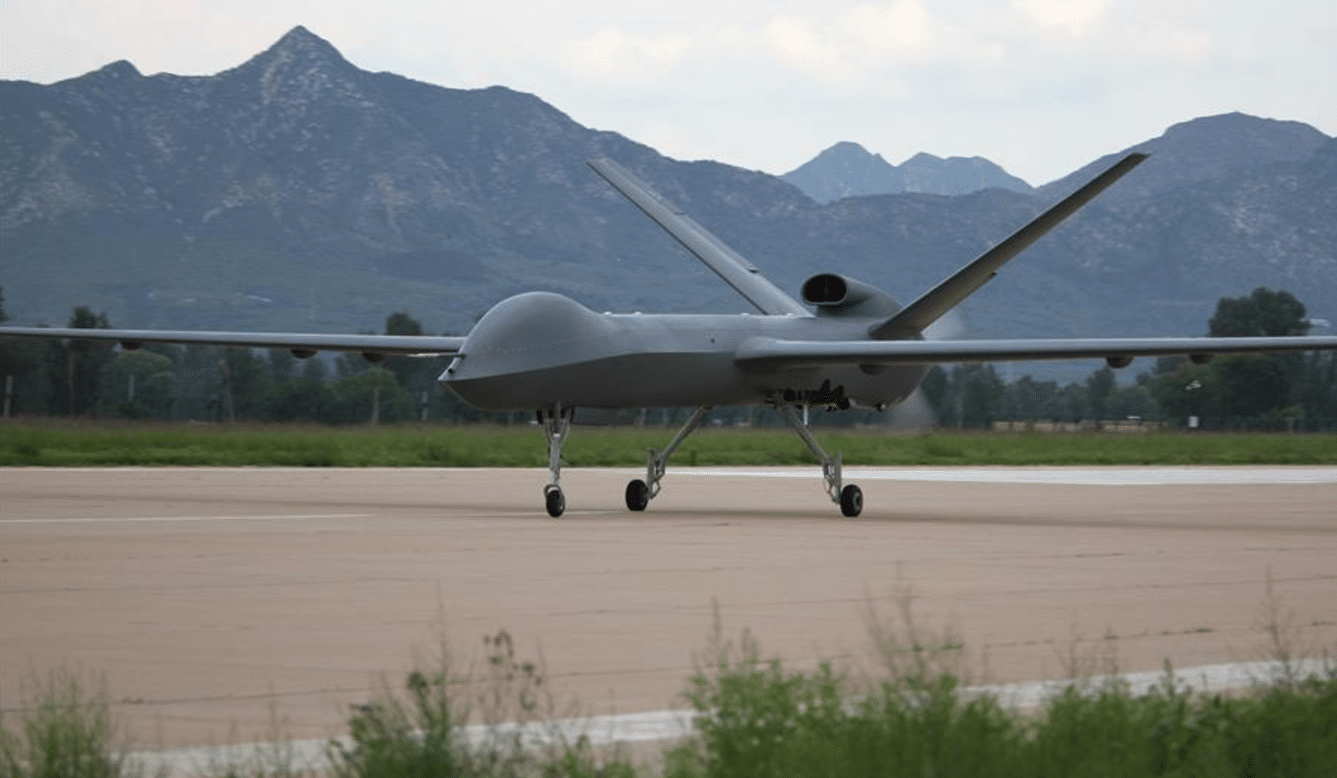2557Views 13Comments

Possible MALE UAV concepts at Pakistan’s Aviation Design Institute
In a promotional video for the breaking-ground event for Air University’s Aerospace and Aviation Campus in Kamra, Pakistan Aeronautical Complex (PAC) revealed design concepts of unmanned aerial vehicle (UAV) designs made by the Aviation Design Institute (AvDI) which may be related to “Project Azm.”
Under Project Azm, AvDI – which is part of PAC – was tasked by the Pakistan Air Force (PAF) to design and develop a medium-altitude long-endurance (MALE) UAV.
While preliminary and tentative, AvDI’s mock-ups broadly mirrored the MALE UAVs being produced in China and Turkey, such as the Wing Loong as well as CH-4 and the Anka, respectively. However, technical specifics such as prospective powerplant, payload, hardpoints and weaponization were not disclosed.
In December 2017, the PAF CAS reportedly stated that the AvDI MALE UAV will materialize in 18 months.
The PAF Chief of Air Staff (CAS) Air Chief Marshal (ACM) Sohail Aman formally announced Project Azm in July 2017 in the inauguration event of the Kamra Aviation City complex, which is envisaged as the home of PAC, AvDI, Air University and other state-owned and potentially private sector aviation companies.
Recently, analysts belonging to the Center for Study of the Drone at Bard College, New York identified a Chengdu Aircraft Industry Group (CAIG) Wing Loong UAV stationed at PAF M.M. Alam in Mianwali by using commercial satellite imagery. It appears that the Wing Loong arrived to Mianwali in late November 2017.
Currently, it appears that Pakistan is continuing its tests of the Wing Loong, having flown it through 2016 under “experimental flights.” CAIG is also test-flying the improved Wing Loong II, which has a payload of 400 kg, top speed of 370 km/h, service ceiling of 30,000 ft and endurance of 32 hours. The Chinese press claim that the Wing Loong II secured its launch export orders before its flight, but it is unknown who has the drones on order, though it is said to be the largest overseas sale of Chinese drones to-date.
Notes & Comments:
The PAF’s UAV attack UAV is the Burraq, produced by the National Engineering and Scientific Commission. It can carry up two laser-guided air-to-ground missiles. Thus far, it appears that the PAF has been using the Burraq for time-sensitive and/or targeted strikes as part of its counterinsurgency (COIN) and counter-terrorism (CT) operations. The PAF has been using the Leonardo Falco and General Industrial & Defence Solutions (GIDS) Shahpar for intelligence, surveillance and reconnaissance (ISR) in its COIN/CT operations.
Pakistan began inducting the Falco in 2009 under a co-production agreement involving PAC and Leonardo. The Falco has a payload of 25 kg available for electro-optical and infrared (EO/IR) turrets. The Falco was later joined by the Shahpar, which has a payload of 50 kg and endurance of seven hours.
The introduction of MALE UAVs – be it the Wing Loong-series or a potentially original design by PAC and AvDI – would provide the PAF with increased attack capabilities and ISR coverages through the use of its drones. It could also spur the introduction of using heavier munitions, such as 100 kg precision-guided bombs, from drones. This would extend the use of these aircraft from time-sensitive strikes and targeted attacks against individuals to close air support (CAS)-level missions in COIN/CT, such as attacking moving vehicles and neutralizing enemy firing positions. In terms of ISR, the PAF can equip these new drones with synthetic aperture radars for real-time image intelligence and use ground-moving target-indication for target acquisition – this information could be provided to other airborne and/or land units via data-link. Pakistan can leverage the endurance of a MALE UAV to sustain a ISR coverage unit for a longer time period.
Video with the above screen-captures and other information regarding the Kamra Aviation City complex:
https://www.youtube.com/watch?v=BaX0brqssD8




13 Comments
by sami shahid
Right… we should develop such drones and deploy them for non stop surveillance. It would be more useful if we use these drones for unilateral actions against our enemies in Afghanistan just like Israel does.
by Asif Khan_47
The Chinese Wing Loong was sighted at PAF AB MM Alam in November. This AvDi projects looks a mirror image of Wing Loong so don’t be surprised Pakistani will be making a big claim of some indigenous UAV???
by PewPew
Maybe but the CAD stuff shows a UAV with a top-mounted wing instead of the mid-mounted wing found on Wing Loong.
by Jigsaw
I think its pretty clear that Pakistan (in particular PAF) has a pretty mature design and manufacturing capability when it comes to small to medium UAVs and UCAVs. Developing that know-how into a next level capable UCAV will not be a major challenge, especially that now PAF is driving this via local R&D and its own engineering varsities. They may employ wing loong alongside as well or on stopgap basis.
PAF actually is the only military arm that has gone to this next of domestic sourcing via solid R&D efforts and technology absorption aim. It will show results.
by jamshed_kharian_pak
Wonderful News Strong Armed Security Forces Strong Economy Strong Islamic Republic of Pakistan Long Live
by Omar
awesome, AvDI indeed seems to be a groundbreaking step.
by Steve
That makes it a different drone altogether
by TZK
Surveillance UAV’s probably more important for Pak especially high altitude long endurance variety that are more or less undetectable by radar and could play a crucial part in any war situation where low orbit satellites are targeted and destroyed or they become unavailable due to geopolitics.
by Jigsaw
Agreed except that Pakistan does not have any notable presence or dependence w.r.t own sats. They’re basically using Chinese system for their military needs.
by TZK
Except in any war situation the Chinese sats also become potential targets unless China then says they cannot be used by Pak.
https://en.wikipedia.org/wiki/Anti-satellite_weapon
https://www.space.com/7764-india-developing-anti-satellite-spacecraft.html
by Joseph
If India were in war with Pakistan then I wouldn’t say shooting down Chinese satellites and practically declaring war on China would be the smartest move for India.
Than again counting on others is never as good as self reliance. Drones these days are far cheaper and could be even more effective and much easier to replace than satellites, except for navigation satellites of course.
by Jigsaw
Everything is a potential target in war. What matters is if the aggressor country has the will and capability to do it. Engaging Chinese sats is not easy just because they’re up there. Nevertheless doing that will see a overwhelming response or even a proactive one from Chinese side. It’s guaranteed because it Chinese property.
Reg Chinese sats not being used by Pak. Based on current chinese-pak engagement, this is an unlikely happening. It is happening now with Pakistan taking intel from Chinese sats and it will continue to happen since sats are not considered weapon per say. Some analysts think it may happen and while Pakistan should work on its own constellation, shutting down of Chinese sat intel may happen only in official statements and news.
the only time it could actually happen is if and when chinese and pakistani interests no longer remain same – as is the case with US and Pakistan and which means US GPS service and other sat service will either be stopped or misguided for Pakistan. I dont see it happening otherwise.
by Jigsaw
true that